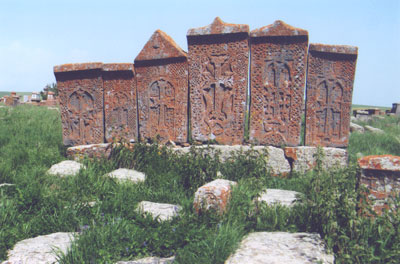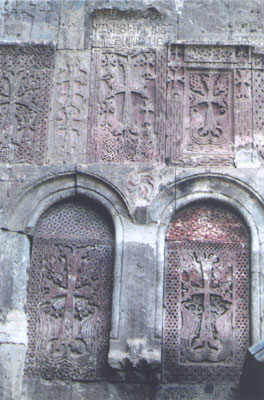Transcaucasus’ Armenia, plus Istanbul
This item appears on page 60 of the July 2011 issue.
by Julie Skurdenis (Second of two parts)
I traveled with my husband, Paul, on a private tour of the three Caucasus countries of Azerbaijan, Georgia and Armenia in May/June 2010. Last month I wrote about the top archaeological site visited in Azerbaijan and in Georgia and selected a handful of other highlights in each country as well. Armenia remains.
In Azerbaijan, the archaeological site selected was a mountainous area riddled with caves containing petroglyphs. In Georgia it was two spectacular cave complexes. In Armenia it was different, since it was not one specific archaeological site but many.
The archaeological highlight of our five days there was the khachkars, elaborately carved stones. They are found all over Armenia, usually close to a church or within it. Often these stones are embedded in the walls of the churches, themselves.
Khachkars
The earliest khachkars date from the ninth century, but the best were probably carved in the 12th to 14th centuries.
They were erected primarily as memorial stones to commemorate the deceased, although some memorialize military victories or even the consecration of churches. Others are reminders to passersby of an individual’s donation to a particular church, especially those stones embedded in a church’s walls.
Generally, freestanding khachkars are three to six feet tall, are carved of stone and have a cross carved in the center surrounded by an elaborate design. Sometimes the design is abstract, sometimes consisting of leaves or vines. Those embedded either on the inside or outside of church walls are usually smaller than the freestanding stones.
There are outstanding examples of khachkars at the following churches and monastic complexes: Saghmosavank (embedded in the walls), Noravank (both freestanding and embedded), Haghpat (both freestanding and embedded) and Echmiadzin, where some of the oldest and/or most beautiful examples have been moved from their original locations and now line a wall in the garden.
The single most beautiful khachkar I saw was one at Goshavank. So delicately carved, it looked as if it were made of lace and not of stone.
The most memorable khachkars, however, were the ones at Noratus on Lake Sevan, where almost a thousand khachkars fill a field. As remarkable as the number of khachkars there is the fact they span over a thousand years, from about the year AD 1000 to those erected just a month or two ago.
Particularly poignant are some of the ancient khachkars standing shoulder to shoulder — sometimes 10 or 12 in a row — marking a family’s burial plot. It is estimated that there are over 40,000 khachkars throughout Armenia.
I fell in love with the khachkars and could have spent weeks admiring them, but Armenia offers much more. First of all are the monasteries, themselves, with or without khachkars. Besides those I’ve already named, we also visited Harichavank, Talin, Zvartnots, Geghard and Khor Virap.
Other Armenian highlights
More highlights — picturesquely located 11th-century Amberd Fortress; Graeco-Roman Garni Temple, built in the first century AD by Armenian King Tiridates; Erebuni Fortress, where a cuneiform tablet was found attributing its building to Argishti I, King of Urartu, in 782 BC; the Matenadaran in Yerevan, housing illuminated medieval manuscripts, and Mt. Ararat, dominating the landscape just across the border in eastern Turkey.
Don’t miss the program of “dancing waters” (music set to fountain water displays) in Yerevan’s Republic Square after sunset.
Add to this list the nighttime views from both our room and the outdoor restaurant at the Tufenkian Avan Hotel high above Yerevan. We dined outdoors on the terrace each of our three nights there. Dinners averaged $60 for two, including food and drinks.
Istanbul finale
Istanbul was not part of our Caucasus itinerary, but we decided to add five nights there on our way back to New York.
Istanbul has always been one of our favorite cities and we’ve been lucky to visit it many times over the years. We made our stopover there a potpourri of our favorite sights: Blue Mosque (which was just across the street from our hotel, the Alzer), Hagia Sophia, Yerebatan Underground Cistern, Grand Bazaar, Kariye/Church of St. Saviour in Chora, Bosphorus cruise and, of course, the incomparable Archaeological Museum.
The only new thing we added was a visit to the new Pera Museum at 65 Mes¸rutiyet Caddesi, where there was a fabulous exhibit of 64 of Fernando Botero’s paintings. Botero is one of Colombia’s foremost artists and sculptors, famous for his “fat” people and animals. There was even a Botero Fat Cat sculpture in Yerevan.
If you go…
Our trip through the Caucasus was arranged by Kutrubes Travel in Boston (800/878-8566). We had private guides and drivers in each country — the best way to travel there, if you can, since you can determine your own schedule as well as how much you want to see and do.
We paid $7,900 for land arrangements for two, which included hotels, guides, drivers, admissions and a few meals) plus another $2,297 for flights from New York’s JFK to Baku, Azerbaijan, via Istanbul and back from Tbilisi, Georgia.
The cost for our five-night independent stay in Istanbul came to about $2,000 for hotel (Hotel Alzer), meals, museum admissions and taxi transportation to all sights not within walking distance.
We flew Turkish Airlines (800/874-8875), about whom I cannot say enough good things. Turkish Airlines is one of the world’s fastest-growing airlines and is now Europe‘s fourth largest. We were upgraded to business class, which meant that we were assigned “pods” that were almost like mini-rooms, with seats that became completely flat for sleeping and included feather-soft quilts.
In my 40 years of flying, I recall only a handful of memorable meals in the air. Turkish Airlines earned its place in this handful with the quality of their cuisine plus the choices offered of either Continental or Turkish specialties.


